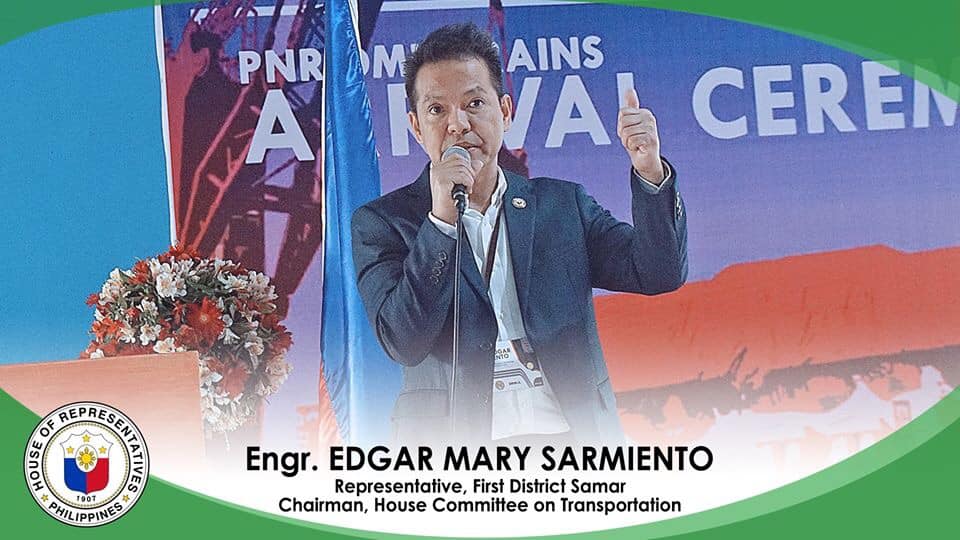Rep. Sarmiento Offers Solution To EDSA Traffic
Rep. Sarmiento Offers Solution To EDSA Traffic

At least 350,000++ vehicles traverse EDSA everyday. Bus, cars, motorcycles, trucks and cabs fill this thoroughfare. And yes, EDSA has been synonymous with TRAFFIC already. Reports have it that at least 7,500 vehicles use EDSA per hour- and its carrying capacity is only 6,000. Much has been done already to ease EDSA traffic. Some failed, some made a little improvement. So, can we still get to experience a ‘convenient’ EDSA?
REP. EDGAR SARMIENTO OFFERS PROPOSAL
House Transportation Committee Chair and Samar 1st District Representative Edgar Mary Sarmiento unveiled recently the blueprint of his proposed centralized and synchronized bus dispatch system which would turn the EDSA’s rowdy and chaotic city buses into a fast, efficient and predictable mass transport system.
Sarmiento, a civil engineer, disclosed the full details of his proposal after announcing that his panel is closely working with the Department of Transportation (DoTr) to craft a roadmap which would solve EDSA’s traffic problem.
In his proposal, Sarmiento said that the innermost lane of EDSA will serve as an “express bus lane” which can be accessed through stations used by the MRT. Like a carousel, the “express bus lane” will just circle around EDSA, duplicating the route of the MRT.
“People who use the MRT can now have the option to ride the bus which will be also operated like carousel. The buses will only load and unload passengers in a synchronized manner at the MRT stations so they are basically an extension of the MRT. Walang magiging traffic dyan because the entire inner lane from Taft Avenue to North Avenue and vice-versa will be enclosed and exclusive to the express bus lane ,” Sarmiento said.
Sarmiento said that the three lanes in the middle of EDSA will be dedicated for all types of private vehicles subject to the existing vehicle reduction programs like the number coding scheme. Private cars will be only allowed to use the outer lane when turning into an intersection.
The outer lane of EDSA or the yellow lane will be used as a dedicated city bus lane which will also adopt a centralized and synchronized dispatch system. Dedicated bus stops will be established one kilometer apart. Loading and unloading of passengers will be strictly implemented on these bus stops.
Sarmiento said that while the express bus lane will cater to passengers who also use the MRT, the city bus lane operation will extend up to the Parañaque Integrated Bus Terminal (PITX) in the south and the Valenzuela Integrated Bus Terminal (VIBT) in the north and vice-versa.
” City buses will now be using the outermost lane in EDSA or the yellow lane. They will be traversing EDSA in a carousel-type system until they reach the proposed north terminal which is the Valenzuela Integrated Bus Terminal. From there, the city buses will now traverse to the south still using the outermost lane until it reaches the proposed south terminal which is the Paranaque Integrated Bus Terminal,” Sarmiento said.
“We propose this to eradicate the kanya-kanya system of the buses wherein they compete with each other creating chaos through overtaking, overspeeding, and overstaying. Puno man o hindi, lalarga po ang mga city buses dahil may schedule na po ang biyahe nila at hindi na sila makikipag-agawan ng pasahero dahil hindi na commission-based ang kita kundi sahod na ang matatanggap ng mga drivers at konduktors,” Sarmiento added.
Sarmiento said that also part of the proposal is to modernize the fare system using tap or beep card.
“Once everything has been set in theory and generated through computer by the MMDA, it will be presented to the public through a dry run, which will be implemented on a day with the least number of vehicles in the road. We are going to have a computer-generated simulation of this proposal to be led by the MMDA,” Sarmiento said to dispel fears that this could end up just like the other failed “experiments” of the MMDA.
Sarmiento clarified however that his proposal can still be subject to improvements and adjustments by the DoTr and the MMDA which is will the frontline implementing agencies.
“Lastly, this proposal is a work in progress. Details will be discussed by the Executives. Ang inyong lingkod, bilang Chairman ng House Committee on Transportation ay willing na magbigay ng suporta sa DOTr kung may mga kailangang polisiya upang maipatupad natin kaagad ang mga planong ito,” Sarmiento said.
Sarmiento said that if and when the plan is set into motion, the private vehicles that continue to clog EDSA middle lanes would be reduced eventually “because people would now start riding the bus rather than drive their car in what is described as one of the world’s biggest parking lot.”
“With this system, if the trains and buses will be fully operational, and the commuting public is now effectively and efficiently being moved, that’s the time that we can reduce the volume of private vehicles in EDSA and the major thoroughfares in Metro Manila,” Sarmiento said.
” Once the volume of vehicles were reduced, that’s the time that we can introduce major infrastructures in EDSA and other major thoroughfares,” he added.








